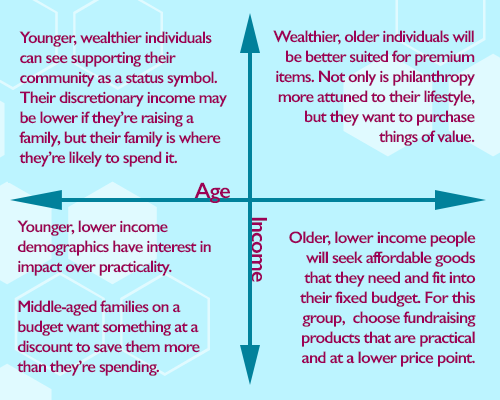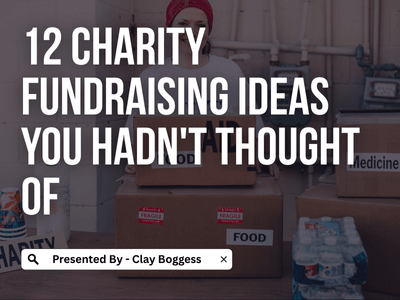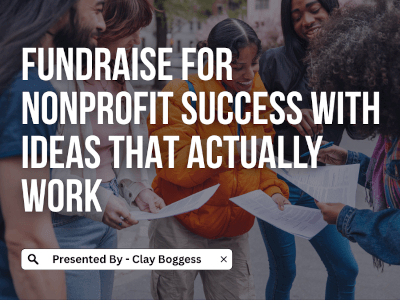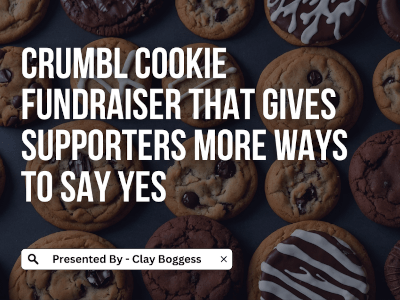
Leverage demographic data to improve school fundraising outcomes.
A regional nonprofit conducted workplace giving campaigns. Their fundraising efforts for the community depended on what hundreds of accounts generated through annual giving pledges and special fundraising events.
This nonprofit served a community with a workforce comprised mainly of professional services, military and blue-collar manufacturing. This meant that volume of donors—and not the average donation—was the most critical factor for a significant proportion of the accounts. Lower median salaries at many companies meant that a pledge of $1 or $5 per pay period in exchange for a jeans day was more excellent incentive value for hundreds of employees than extravagant rewards for high-level donations. These smaller fundraisers drove value by volume.
Year after year, the nonprofit pulled in more than $20 million for their region, resulting in funding for critical programs and services.
While significant individual and corporate gifts doubtlessly bolstered this, most of the sum was still driven by workplace giving campaigns. What drove their success? The answer is a commitment to a data-driven understanding of the corporate culture of giving and sound contextual data to help understand each company's demographics.
The good news is most schools, churches, clubs, and sports teams don't have a $20 million annual goal. The bad news is most schools, churches, clubs, and sports teams don't expect these core truths about fundraising to apply to them. No matter the size of your goal or organization, you can use a suite of free tools to implement what fundraising guru Penelope Burk calls donor-centered fundraising by learning the age, socioeconomic background, behaviors, and culture of where you're fundraising. Then, you can start working with fundraising ideas that work.
The School Fundraising Landscape
Big Fundraising Ideas believes in putting quality products in the hands of groups to help them meet their fundraising goals. Our goal is to deliver the best fundraisers for elementary, middle, and high school students. We also believe in giving you the tools you need to help you choose the right product for your audience, which is why demographic data is a powerful part of strategic fundraising.
Make no mistake: in the information age, every creative, high-profit fundraising idea can and should be guided by a strategy grounded in facts. There's a lot of information to help you plan and execute a successful fundraiser, but it's essential to know the broad context of your undertaking.
The National Association of Elementary School Principals (NAESP) studied the scope of school fundraising across the United States. Nearly 94% of schools use fundraisers to supplement necessary expenses, and the most significant proportion of fundraisers generated more than $75,000 or less than $5,000 annually.
From this, we can reasonably infer that fundraisers are pervasive in the educational community. The absence or presence of wealth, the average age of a community, consumer behaviors, and even cultural trends have little to no bearing on whether or not a school will fundraise. For your school, competition with other schools—and community organizations and nonprofits—is an almost certain factor to consider when meeting your goals.
Add to that NAESP's estimate that most schools will conduct between 1-5 fundraisers annually, and even unique product selection may not be enough to help your school reach its goals. To be on the cutting edge of fundraising, even schools must consider their audience, and to do so, they need to make data part of the equation.
In our earlier anecdote, the nonprofit, while significant, was still one among hundreds in a central metropolitan area. They, too, contended with competition from other nonprofits that very likely could make more emotional appeals and had more attainable goals. But what our example did so well made appropriate asks for the potential donors before them—something they could do only because they had data-driven approaches to fundraising. Just as they might ask a tenured C-suite executive later in her career for a $10,000 annual commitment and membership in an elite donor society, so you might ask older neighbors in a country club to consider purchasing premium flowers for your sports team based on income and age, both of these groups likely have more disposable income. According to John Maynard Keynes, they're more likely to spend because of it.
This common-sense, facts-and-figures approach to fundraising might seem obvious. Still, a research-backed fundraising strategy might be the last thing a PTA or PTO endeavors to consider before launching a schoolwide campaign in addition to their other responsibilities.
Big Fundraising Ideas has curated some of the best free resources to help you assess the demographics of your target area. With these in your toolkit, you'll be able to cut through the competition by effectively targeting your products to the areas and audiences where your school (or community group) will be carrying out its fundraiser.
Fundraise to the Ages
It might not seem like a fundraising tool, but every ten years, you get that bulky mailer from the U.S. government asking your age, household income, number of children, and a litany of other questions. It's tedious but provides some of the most valuable information our nation gleans. Many don't know that this information is readily available to everyone via the Internet.
That's right—the U.S. Census might just be one of your school fundraiser's best friends. With the bonus of providing an excellent opportunity for your students to use a robust research database, the online census allows users to look at information down to the zip code. You can find general statistics (usually medians) relating to household income and size. It's also one of the primary databases that can give you an accurate idea of the median age of an area.
It's tempting to assume an area around an elementary school is full of young families, but other zip codes may be skewed much older or younger in your school's zone. And, despite what they say, age is more than just a number. Age data gives you a sense of what might be helpful or appealing to a given audience, which can quickly help you pick the right product to put in the hands of eager student sellers.
Applying Age Data to School Fundraising
Most schools and school districts can provide the zip codes for which any one school is zoned. Start your planning by gathering this information, then head to census.gov to pull (at least) the median age and household income for each zip code. Once you have this information, average it to get a general idea of your work.
Consider the following analytical processes that can help you make valuable inferences about fundraising from your data:
- Skip Number One- Parents and fundraising planning committees may find that the primary demographic of the area they're targeting is their own, which could mean that their neighbors have children participating in the same fundraiser. In this case, focus on a considerable secondary age or income bracket.
- Mediate Age and Income- As mentioned above, age and income are interdependent pieces of demographic data. An older, wealthier person may be a more likely supporter of your school fundraising ideas as someone with expendable income and no children of their own in the same school. A box of delicious chocolates in exchange for supporting their local school seems like a nice treat.
Conversely, an older, lower-income person might be on a fixed budget. While they might love to offer community support, they could find it challenging to contribute to something they do not need. Still, a younger, lower-income millennial might be willing to purchase if compelled enough by the cause.
See the grid below to understand how these factors influence the types of products you should consider.

Fundraise to Personas
Nielsen might be most synonymous with television monitoring. Still, their big data solutions have made them a leader in developing consumer personas—a profile based on intersectional factors like those demographics mentioned above, plus stages of life, types of employment, and even spending habits.
Like the U.S. Census, Nielsen drills down to the zip code, making it another valuable tool for the fundraising crew at any school or community organization. Their MyBestSegments tool is a free service using Nielsen's Prizm Segmentation System that provides a limited look at high-level information about the personas that comprise a zip code. The quirky, creative, and surprisingly insightful profiles can help you understand the "type of person" your student body might be marketing its fundraising solutions.
The Nielsen profiles are by no means meant to glaze over a given area's diversity, but they help distill a lot of data into pre-packaged interpretations for which marketers used to pay hefty fees. See if your school fundraiser needs ideas for "Bedrock America" or "Bright Lights, Li’l City" neighborhoods.
Applying Personas to School Fundraising
Age and income may eliminate a handful of options from all the possible fundraising solutions before you, but adding the Nielsen profiles can add a new layer incorporating more qualitative interests grounded in quantitative data.
If you're trying to decide between a candy bar fundraiser and a popcorn fundraiser, go beyond the price point and consider Nielsen. Is the area particularly interested in health and wellness? Or maybe there are many suburban retail areas, making it an excellent fit for discount cards.
While these profiles provide a beneficial qualitative coloring of your possible fundraising participants, don't stray too far from the facts. Hopefully, Nielsen is a supplement to the Census data. Use the personas to help make a more informed choice about your product, and then create a long-term fundraising strategy to share impact and engage with your school's supporters over time.
Simply put, these personas might be more beneficial in figuring out how to make pitch to your audience than figuring out what to pitch to them. Nevertheless, these characterizations should be given their due diligence.
Fundraise to Your Local Culture
You know your network better than anyone, so in many ways, the most potent source of information and "data" for school fundraising efforts are those people you do life with daily.
Reflect on your circles. Do distinctly different groups come to mind? Are their interests shared or varied? Maybe there's a point of commonality that links them all together. This is good information to help qualify your data and integrate it into your school fundraising ideas.
The relationships you form in the communities where you and your family live, work and play can make for powerful prospect lists. Consider what interests the ten people you know you could sell to. Which brochure has products that might appeal to them most and help you raise money for your school?
Applying Cultural Data to School Fundraising
Understandably, many people are reticent to ask colleagues or other parents with children to participate in a school fundraiser. Even if you don't want to make them potential customers for a fundraising solution, their opinion is data worth having. Ask those in your network what most appeals to them, and conduct an informal survey.
Consider questions such as:
- How much would you be willing to spend for a perishable good if you both enjoyed it and knew it would support a good cause?
- What types of treats are most appealing to you?
- Are you more willing to buy a practical item or a sweet treat to help a school cover unfunded expenses?
This is an effective way to link your sales to a cause and might elicit some interest. You can return these results to your other collected data and see if it aligns with the hard facts. If you can, consider the demographic of those you surveyed versus the information you gleaned from the above databases.
Combined, these tools can be powerful ways to transform your school fundraising ideas into robust fundraising strategies to amplify your results, raise big money, and meet your goals.
Author Bio
Clay Boggess has been designing fundraising programs for schools and various nonprofit organizations throughout the US since 1999. He’s helped administrators, teachers, and outside support entities such as PTAs and PTOs raise millions of dollars. Clay is an owner and partner at Big Fundraising Ideas.



